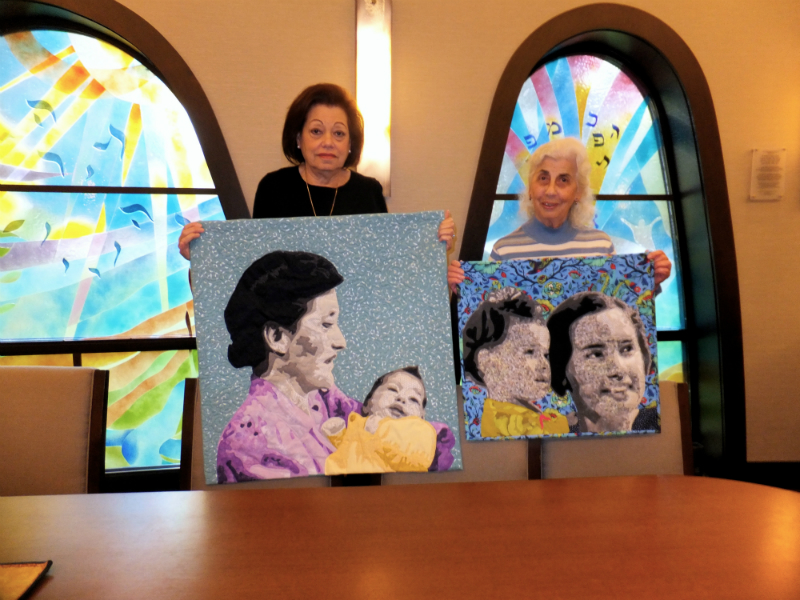Lingering memories of a time that was, for the longest time, too painful to remember, have found a comforting place in the hearts of two Holocaust survivors.
Ruth Smith, 86, and Elly Friedman, 76, are grandmothers who have never before spoken of their courageous journey of survival. Smith was born in Germany and moved to Belgium in 1938. Friedman was born in Amsterdam. As young girls, they were hidden: Smith by a nun and Friedman by a farmer’s wife. They were lucky enough to survive the war with their personal memories carefully tucked away alongside treasured photographs of the brave women who risked their lives to save them.
Now, Smith and Friedman have brought those faded photographs to life. Under the leadership of Stephanie Kepecs, and as part of the Golden Hands Quilting Club at Toronto’s Adath Israel Congregation, the two survivors sewed these hauntingly beautiful portraits of themselves as young children with their adoptive and birth mothers into intricately stitched memory quilts.
In partnership with Holocaust Education Week, Adath Israel Congregation is inviting the community to meet and speak with the artists on Nov. 6, from 7:30 to 9:30 p.m. in an event called Bringing Memory to Life.
“This story is unique because the artistry is linked with these women’s dedication to preserve their family memories. They were weaving both story and threads to make the quilts live on,” said Nancy Goldstein, Adath Israel Congregation’s director of membership services and development.
In 1948, under the auspices of the Canadian Jewish Congress, Smith, then 16, travelled to Canada with her two younger sisters and eventually settled in Toronto, where she was adopted.
“My grandmother, Frieda Kahn Silberstein, survived the war and gave me photographs of my mother, Lotte Silberstein Klein,” said Smith. “I had a beautiful picture of us hidden away in my cupboard for many years.”
Friedman described her journey: “On the day I was born – May 5, 1942 – all Dutch Jews began wearing the yellow star. (When) I was just nine months old, against the will of my father, Sallie Meibergen, my mother gave me to a non-Jewish family to protect me from the Nazis. Dr. Tini V.D. Bilt worked with the underground in Holland and placed me with farmers for the duration of the war. I was reunited with my mother in 1945. We were the only members of our family that were spared from Nazi death camps. Yad Vashem recognized Dr. V.D. Bilt as a Righteous Gentile, planting a tree in her honour.”
READ: ISRAELI ORGANIZATION WORKING TO EMPOWER YOUNG GIRLS
Friedman was 15 when she travelled with her mother, Chaja Meibergen, to Canada, where they settled in Montreal.
“We came on a freighter, nobody brought us over. My mother always told me because of that picture of us, she had the will to live and to see me after the war,” said Friedman.
The memory quilt project took the pair almost three months to complete.
“I was working with skilled women,” said Kepecs. “Elly and Ruth have been working with their hands all their lives. Quilting is not for someone who has never worked with fabric before. Elly was the first to volunteer. She showed me her photograph and said, ‘This is my Catholic mother and I’d like to do this project.’ ”
“Once Ruth saw Elly’s completed quilt, she said, ‘I want to do one of my mother,’ ” said Kepecs.
Portrait quilting is an art form that requires oodles of patience. The women met weekly to stitch the pieces, layer the quilts and bind the edges.
“It’s almost like putting together a jigsaw puzzle,” said Kepecs. “You have the picture. You have to cut it apart and then put it together again.”
It’s been said that a picture is worth a thousand words. As weeks passed and the quilts became more and more detailed, the group noticed that both women bore a strong resemblance to their respective mothers. That was a tipping point. Tentatively, Friedman shared her long-repressed personal story of her family life and her time on the farm.
“Ruth was hesitant,” Kepecs explained. “But when we finally finished, I held her quilt up to her and she started to cry. She had spent so many hours working on her mother’s face. It was very emotional.”
Smith and Friedman’s painstakingly, and lovingly, created works of art are their legacies. They will live on for their children, grandchildren and future generations, so that they may never forget.
